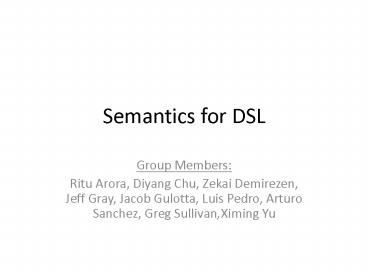Semantics for DSL - PowerPoint PPT Presentation
Title:
Semantics for DSL
Description:
Proving properties of a GPL is challenging, but should be easier ... properties ... OCL to define pre and post conditions. Used for simulation purposes ... – PowerPoint PPT presentation
Number of Views:34
Avg rating:3.0/5.0
Title: Semantics for DSL
1
Semantics for DSL
- Group Members
- Ritu Arora, Diyang Chu, Zekai Demirezen, Jeff
Gray, Jacob Gulotta, Luis Pedro, Arturo Sanchez,
Greg Sullivan,Ximing Yu
2
What do semantics mean for a modeling language?
- The details about the concepts that are in the
mind of the domain-experts should be written
formally. - The semantics represent the meaning of the
phrases and sentences that the domain expert may
express. - Box Represents a State? Class? Foo?
3
Why do we want a clear and precise representation
of model semantics?
- A clean formalism enables reasoning about desired
properties - Analysis
- deadlock analysis
- ambiguity?
- consistency?
- Generation of associated tools from the semantics
definition - Code generators
- Debugging tools
- Test cases
- Visualization of execution/animation
4
How to define the semantics for DSL?
- The state of the art represents model semantics
at a low-level - Defined in model interpreters
- Emerging approaches
5
Domain-Specific Semantics
- Are the semantics of the DSL actually
domain-specific? - Lack of a standard for defining semantics for
DSLs - The notion of static semantics is easy and
already defined in many tools dynamic semantics
represent the clear challenge - Proving properties of a GPL is challenging, but
should be easier for DSLs (e.g., behavioral
preservation of transformations, ambiguity) - Domain-specific properties
- would be helpful if semantics are defined in a
formal, declarative language
6
Concerns for defining DSLs
- Concern
- separate syntax semantics
- define roles (language engineer, end-user)
- define appropriate semantic domain
- Document object model
- Abstract state machine
7
Current Approaches 1
- Graph rewriting
- ATOM3 (multi -formalism approach)
- Any thing that can be defined as a model can be
used as a meta-model - Subset of Python, OCL to define pre and post
conditions - Used for simulation purposes
- Combine Syntax and Semantic definition formalisms
in one language. - Kermeta
- Extends EMOF to enable behavior definitions of
meta-elements
8
Current Approaches 2
- Semantic Anchoring through transformation
- Mapping meta elements in to semantic elements in
another formalism with well-defined semantics - Example
- Finite State Machine can be used along to define
the semantics of the DSL - Transformation view on the next slide
9
Operational Semantics
Model-Driven Engineering Technical Space
Anchor FSM Technical Space
myDSL Technical Space
Conforms to
Conforms to
Conforms to
M3
EBNF
EBNF
KM3
Conforms to
Conforms to
myDSL.gGrammar
myDSL Metamodel
FSMDSL Metamodel
FSMDSL.g Grammar
M2
Conforms to
Conforms to
myDSL to FSMDSL Transformation
Injection
myDSL Model
FSMDSL Model
FSM.fsmdsl
myDSL.dsl
Extraction
M1
Legend M1 Terminal model level M2 Metamodel
level M3 Meta- metamodel level































